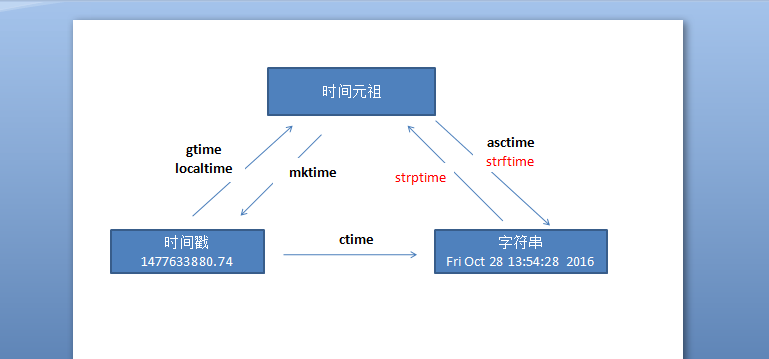Python时间模块 time 解读
发布时间:2019-07-11 09:49:43编辑:auto阅读(1994)
Python time模块解读,陆续更新常用模块
Epoch指的是一个特定的时间:1970-01-01 00:00:00 UTC。
1、time() -- return current time in seconds since the Epoch as a float
以epoch作为浮点返回当前时间(以秒为单位)
time.time() --> 1477633880.74
2、clock() -- return CPU time since process start as a float
返回进程开始或第一次调用clock()的CPU时间,这具有与系统一样的精度。
3、sleep(seconds) -- delay for a number of seconds given as a float
延迟一定数量的秒作为浮点
4、gmtime(seconds=None) -- convert seconds since Epoch to UTC tuple
将从Epoch开始的秒转换为UTC元组
time.gmtime() --> time.struct_time(tm_year=2016, tm_mon=10, tm_mday=28, tm_hour=5, tm_min=52, tm_sec=54, tm_wday=4, tm_yday=302, tm_isdst=0)
5、localtime(seconds=None) -- convert seconds since Epoch to local time tuple
将从Epoch开始的秒转换为本地时间元组
time.localtime() --> time.struct_time(tm_year=2016, tm_mon=10, tm_mday=28, tm_hour=13, tm_min=53, tm_sec=31, tm_wday=4, tm_yday=302, tm_isdst=0)
6、asctime(p_tuple=None) -- convert time tuple to string
将时间元组转换为字符串,例如 'Sat Jun 06 16:26:11 1998'。
当时间元组不存在时,由localtime()返回的当前时间
用来。
time.asctime() --> Fri Oct 28 13:54:28 2016
7、ctime(seconds=None) -- convert time in seconds to string
将以秒为单位的时间转换为字符串,无参数,默认localetime()
time.asctime() --> Fri Oct 28 13:56:18 2016
8、mktime(p_tuple) -- convert local time tuple to seconds since Epoch
将本地时间元组转换为自Epoch以来的秒数,需要参数
time.mktime(time.localtime()) --> 1477634240.0
9、strftime(format, p_tuple=None) -- convert time tuple to string according to format specification
根据格式规范将时间元组转换为字符串
time.strftime("%Y-%m-%d %X %a",time.localtime()) --> 2016-10-28 14:00:07 Fri
10、strptime(string, format) -- parse string to time tuple according to format specification
根据格式规范将字符串转换为时间元组time.strptime(time.asctime()) --> time.struct_time(tm_year=2016, tm_mon=10, tm_mday=28, tm_hour=14, tm_min=8, tm_sec=52, tm_wday=4, tm_yday=302, tm_isdst=-1)
总结:
Python 日期格式化格式
python中时间日期格式化符号:
%y 两位数的年份表示(00-99)
%Y 四位数的年份表示(000-9999)
%m 月份(01-12)
%d 月内中的一天(0-31)
%H 24小时制小时数(0-23)
%I 12小时制小时数(01-12)
%M 分钟数(00=59)
%S 秒(00-59)
%a 本地简化星期名称
%A 本地完整星期名称
%b 本地简化的月份名称
%B 本地完整的月份名称
%c 本地相应的日期表示和时间表示
%j 年内的一天(001-366)
%p 本地A.M.或P.M.的等价符
%U 一年中的星期数(00-53)星期天为星期的开始
%w 星期(0-6),星期天为星期的开始
%W 一年中的星期数(00-53)星期一为星期的开始
%x 本地相应的日期表示
%X 本地相应的时间表示
%Z 当前时区的名称
%% %号本身
上一篇: 3DMAX三维设计
下一篇: SSH系列:(3)Hibernate
- openvpn linux客户端使用
51730
- H3C基本命令大全
51389
- openvpn windows客户端使用
41820
- H3C IRF原理及 配置
38592
- Python exit()函数
33073
- openvpn mac客户端使用
30082
- python全系列官方中文文档
28750
- python 获取网卡实时流量
23746
- 1.常用turtle功能函数
23656
- python 获取Linux和Windows硬件信息
22027
- Ubuntu本地部署dots.ocr
29°
- Python搭建一个RAG系统(分片/检索/召回/重排序/生成)
2252°
- Browser-use:智能浏览器自动化(Web-Agent)
2942°
- 使用 LangChain 实现本地 Agent
2455°
- 使用 LangChain 构建本地 RAG 应用
2396°
- 使用LLaMA-Factory微调大模型的function calling能力
2986°
- 复现一个简单Agent系统
2405°
- LLaMA Factory-Lora微调实现声控语音多轮问答对话-1
3206°
- LLaMA Factory微调后的模型合并导出和部署-4
5275°
- LLaMA Factory微调模型的各种参数怎么设置-3
5102°
- 姓名:Run
- 职业:谜
- 邮箱:383697894@qq.com
- 定位:上海 · 松江

